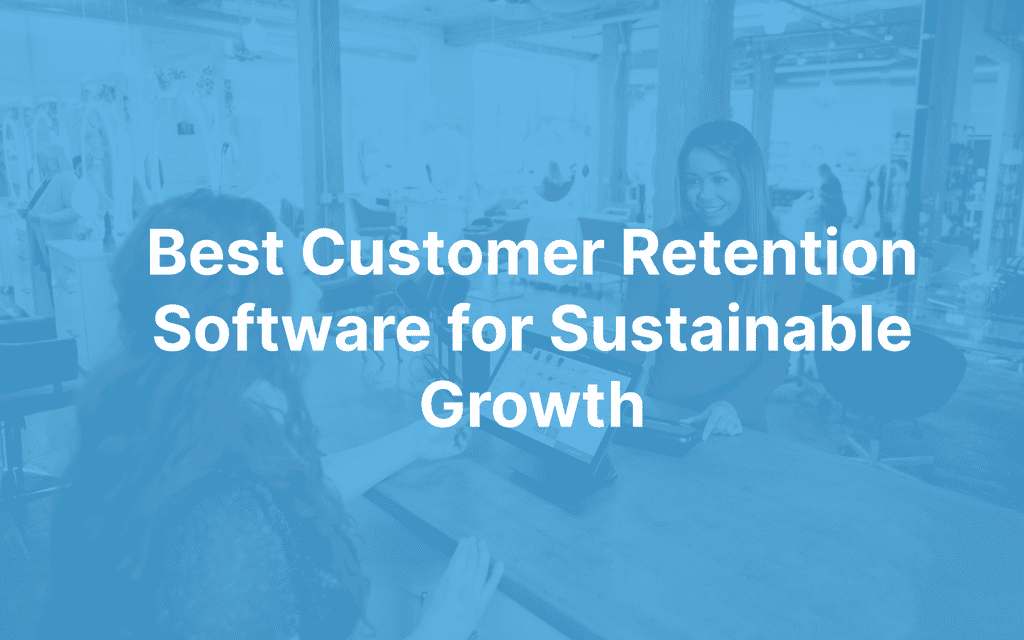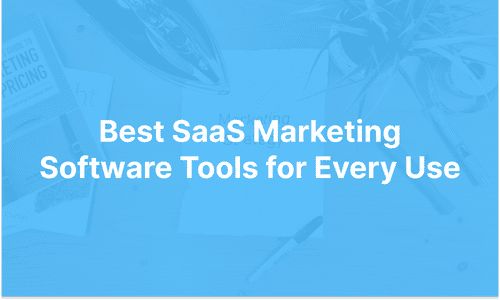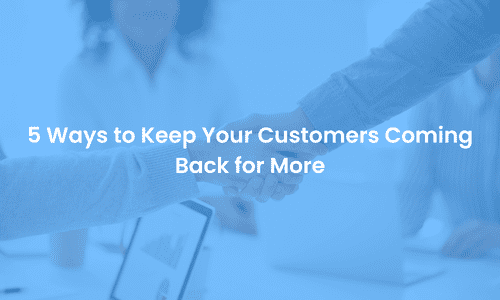Customer acquisition is powerful, but it isn’t the secret to sustainable growth—especially in the SaaS industry. No—that title belongs to customer retention.
Not convinced? That’s understandable—customer acquisition is flashy and exciting. But it’s important to remember that a 5% increase in customer retention rate can lead to a 25-90% increase in profits.
To optimize customer retention, it helps to have the right set of tools. So, in this Customerly guide, we’ll be introducing you to ten of the top customer retention tools on the market.
Let’s get to it.
What Is Customer Retention Software?
Customer retention software isn’t a well-defined software category like CRM or product analytics software. In fact, tools in both of these categories can often be customer retention tools as well.
Instead, customer retention software is a loose group of tools that (you guessed it) help you retain customers through relationship building, support automation, feedback collection, analysis, etc. It can be as simple as introducing live-chat features for customers needing support, something that Nibol implemented to build stronger relationships with their users.
Why Is Customer Retention Software Important?
There are too many reasons to cover in full here, but we’ll hit you with the highlights:
Lower Churn Rates
Churn is the opposite of retention. And while it’s inevitable, it’s a major problem for SaaS businesses relying on MRR to cover payroll, product development, acquisition, and support.
The average churn rate across the SaaS industry is 3-8% month over month. By optimizing for retention using software, you can reduce that by quite a bit. For example, improving your subscription flow can cut our churn rate by 10-30%.
Increase Lifetime Value
When customers stick around, they contribute more to your bottom line.
The obvious reason for this is that they make more monthly payments which add up to a larger amount. The less obvious reason is that they’re also more likely to spring for add-ons, extras, and advanced plans.
All told, existing customers spend 67% more than new customers. Customer retention software allows you to recover near-churned existing customers.
Maximize ROI
As we mentioned in the intro, a small increase in retention rate can have a massive impact on profits. The reason is simple—you don’t need to spend as much to keep a customer as you do to win one.
When you use a customer retention tool to keep an existing customer happy, you’re protecting yourself from a potentially hefty expense (in the form of CAC). It’s an easy way to maximize the ROI of your marketing and sales efforts.
What Should You Look for in Customer Retention Software?
Choosing software is hard. To make things a bit easier, here are a few criteria you can use to evaluate the customer retention tools that you’re considering:
Actionability
Data without any kind of guidance from the tool you’re using can usually help you define problems but may not always help you solve them. Unless you have a data science degree, you’re probably going to want a tool that offers actionable insights for improvement. It’s an important aspect of the customer feedback loop, which will continually help you improve your business’s relationship with users.
Integrations
No business process is an island—especially not retention efforts. Your tools should have some degree of data transfer to limit busy work and promote better insights.
Automation
Automation is a major plus for any tool that’s dealing with repeated workflows. The ability to set and forget automation rules takes a huge burden off of your shoulders and ensures that actions are executed systematically.
Affordability
Last but not least, you need to make sure the tool is within your budget. On the plus side, good retention software almost always pays for itself!
10 Best Customer Retention Software
If you’re in a rush, we won’t keep you waiting. Here’s a quick rundown of the tools we’ll be covering:
- Customerly: Best Overall Customer Retention Tool
- Tidio: Best for E-Commerce Customer Support
- Open Loyalty: Best for Rewarding Loyal Customers
- Qualaroo: Best for In-Context Surveys
- Keap: Best Small Business CRM
- ActiveCampaign: Best for Personalizing Sales & Marketing
- Userpilot: Best for In-App Experiences
- Customer.io: Best for Creating Messaging Funnels
- Totango: Best for Quantifying Customer Success
- ClientSuccess: Best for Flexible Customer Success Dashboards
If you’re curious about why we’ve picked these tools—read on!
1. Customerly
Best Overall Customer Retention Tool
Customerly is an all-in-one customer service platform that helps SaaS businesses understand, engage, retain, and even onboard customers.
To understand them, you can use custom and pre-built surveys to gain product and sentiment insights that guide development. To engage them, Customerly combines a best-in-class live chat tool with a powerful marketing automation engine to make sure you’re reaching customers at key moments.
All the data you collect is stored in Customerly’s CRM, where it can be used to add context to support tickets or as fuel for deep analysis.
Key Features
- Live Chat: Engage your customers with a powerful live chat tool—complete with triggers, intelligent routing, canned responses, and an integrated help center.
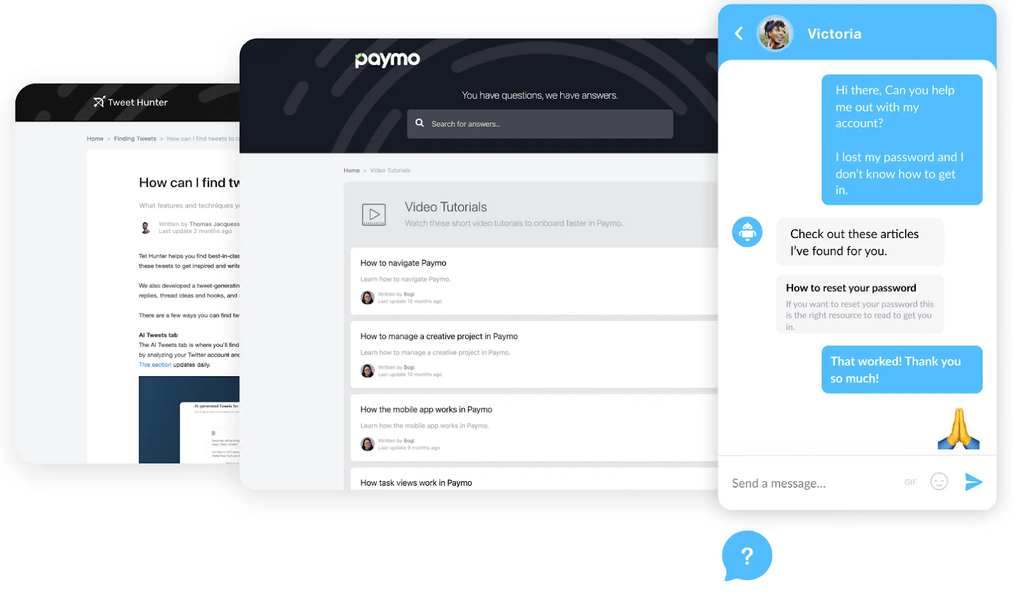
- Shared Inbox: Give your whole team access to every support ticket, email, and chat to encourage collaboration and better resolutions.
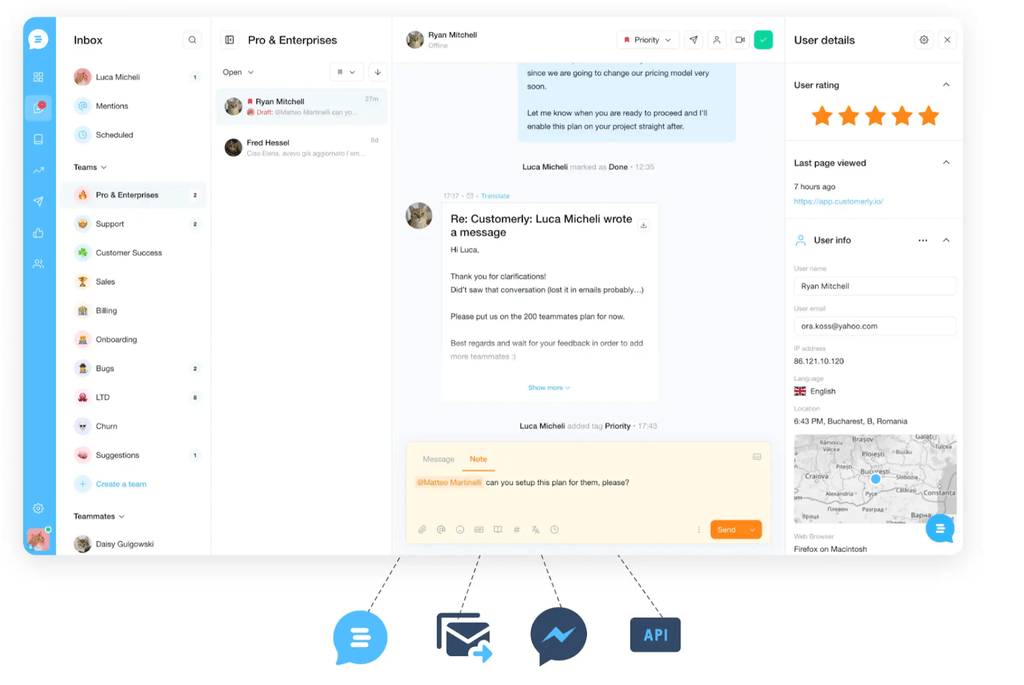
- Marketing Automation: Reach out to customers at key moments using complex funnels built with a drag-and-drop editor.
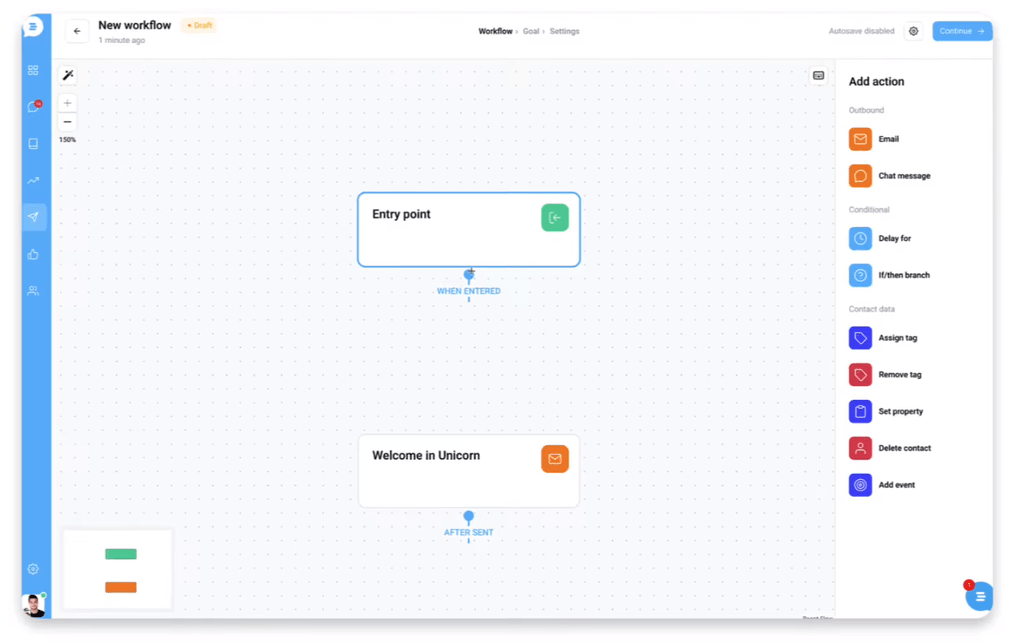
- Surveys & Feedback: Collect feedback using pre-built and custom surveys, questionnaires, ratings, and prompts.
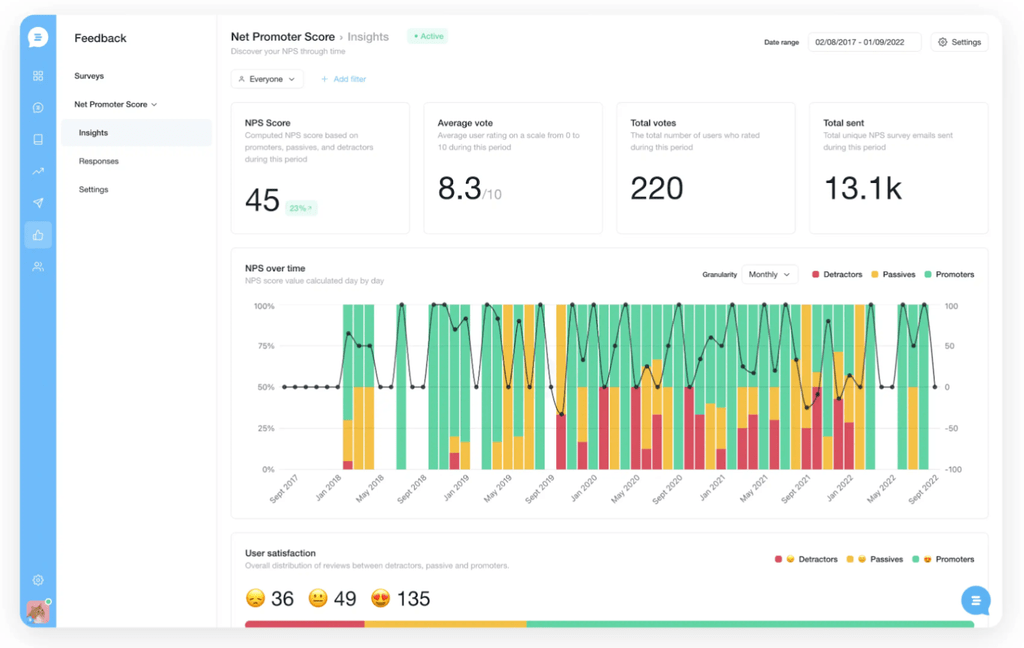
Pricing
Customerly offers a Basic free-forever plan that gives one agent access to core features like the help center, live chat, and surveys.
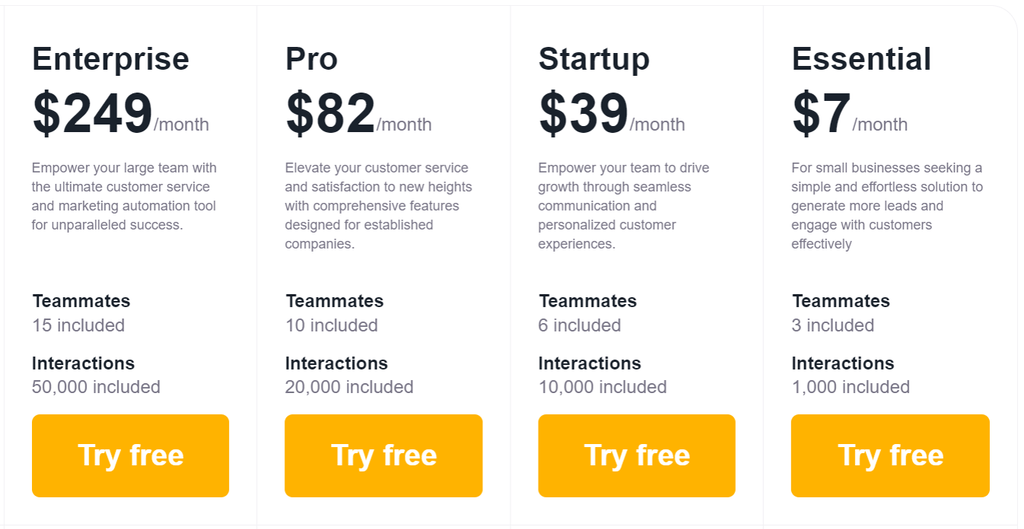
For paid plans, we have options for all kinds of businesses. Essential ($7/month), Startup ($39+/month), Pro ($82+/month), and Enterprise ($249+/month) are all customizable based on the number of interactions or teammates you need.
We also offer a 14-day free trial so that you can test the platform out before committing.
Pros & Cons
Pros
- A comprehensive set of customer retention tools.
- Best-in-class live chat system.
- Powerful, no-code marketing funnels.
- Self-service options for customers.
- Free trial and free-forever plan.
Cons
- Fewer integrations than other options.
2. Tidio
Best for E-Commerce Customer Support
Tidio is a customer service platform that helps e-commerce businesses (especially Shopify businesses) deliver outstanding service.
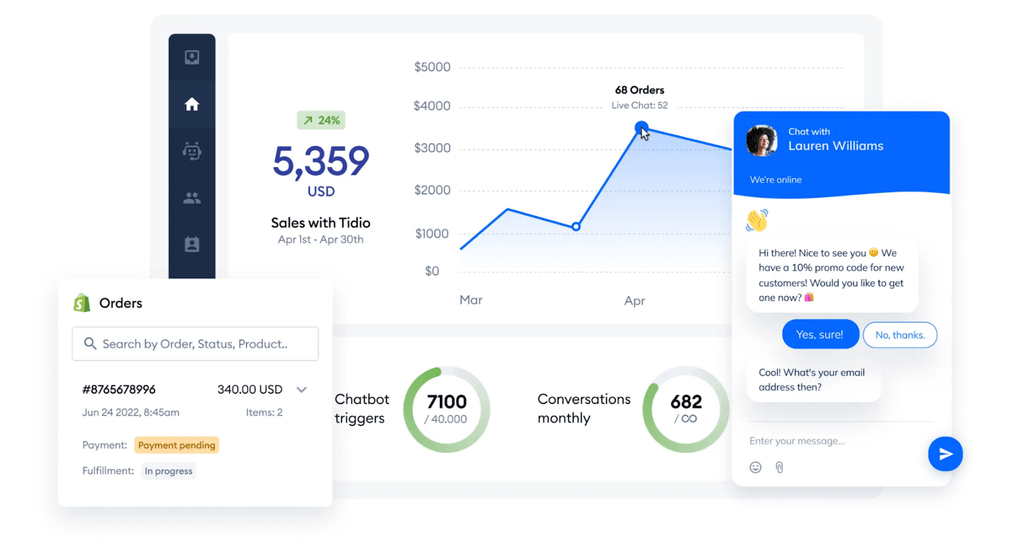
Tidio pairs so well with Shopify thanks to a native integration that allows for actions live previewing the customer’s cart, recommending products from the catalog, viewing order histories, and canceling orders via chat.
All of these features are packaged with the core helpdesk features you’d expect—ticketing, live chat, and analytics.
Key Features
- Multichannel Chat: Communicate with customers via Messenger, Instagram, and email through a single inbox.
- Shopify Integrations: Perform key Shopify actions without leaving the chat to speed up resolution times.
- AI-Powered Chatbots: Create NLP-powered chatbots that lighten the burden for support staff.
Pricing
Tidio has a very limited free plan that supports 50 live chat conversations and 100 live chat triggers.
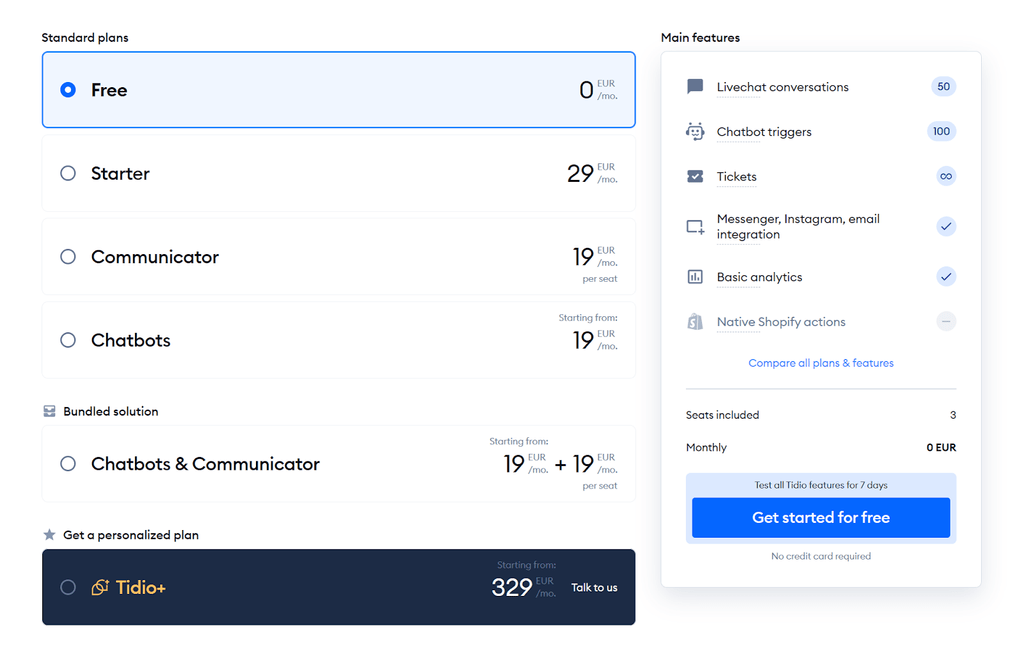
Starter (€29/month) is designed to be a good, balanced entry point for small businesses, but Communicator (€19/month) and Chatbots (€19+/month) offer much better value. By bundling these two plans, you’re getting unlimited live chat conversations and up to 40k live chat triggers.
Pros & Cons
Pros
- Easy to use
- Customizable design
- Offers a mobile app
Cons
- Limited customization options
- Advanced chatbot features missing
- Limited ability to automate customer engagement
3. Open Loyalty
Best for Rewarding Loyal Customers
Open Loyalty is an API-first loyalty program software that allows businesses to reward customers for sticking with them.
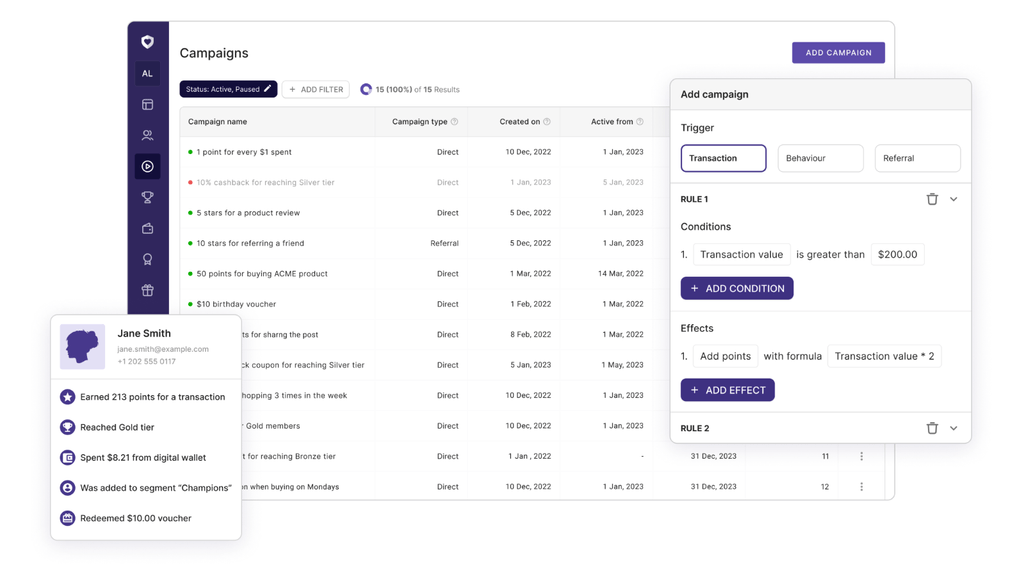
There are a ton of great capabilities that deserve a mention—from points and tiers to referrals and rewards. You have a ton of flexibility to gamify the customer journey in ways that encourage more frequent, higher-value orders over a longer customer lifespan.
Plus, the headless model makes it easy for Open Loyalty to mesh with your existing tech stack—no need to cut out tools you know and love to benefit from this one.
Key Features
- API-First Architecture: Integrate your existing tech stack with your loyalty program and reward customers wherever they engage with your brand.
- Tons of Capabilities: Pick and choose from a wide range of gamified reward and loyalty capabilities.
- White Label Mobile App: Give customers a branded mobile app to track points, referrals, vouchers, and more.
Pricing
You’ll need to contact sales for a quote.
Pros & Cons
Pros
- Customizable in terms of design and features
- Easy to integrate via API
- Mobile support
Cons
- No publically available pricing
4. Qualaroo
Best for In-Context Surveys
Qualaroo is an enterprise-ready customer and user research tool trusted by some big names like eBay, Twilio, Shopify, and Glassdoor.
Qualaroo uses contextual feedback nudges to catch customers in the heat of the moment when feelings and opinions are fresh. When it comes time to analyze this feedback, Qualaroo uses IBM Watson to offer AI-assisted sentiment analysis—perfect for quick, actionable insights for improving retention.
Qualaroo is a great choice for enterprise-level research thanks to its unlimited survey nudges and responses.
Key Features
- AI Sentiment Analysis: Yield insights at the click of a button using IBM Watson.
- Contextual Nudges: Launch surveys on any page, app, or product in response to any trigger you’d like.
- Unlimited Responses: Collect and analyze as much data as you can on any plan.
Pricing
Qualaroo’s entry-level Essentials plan ($64/month) offers unlimited nudges and responses for one domain.
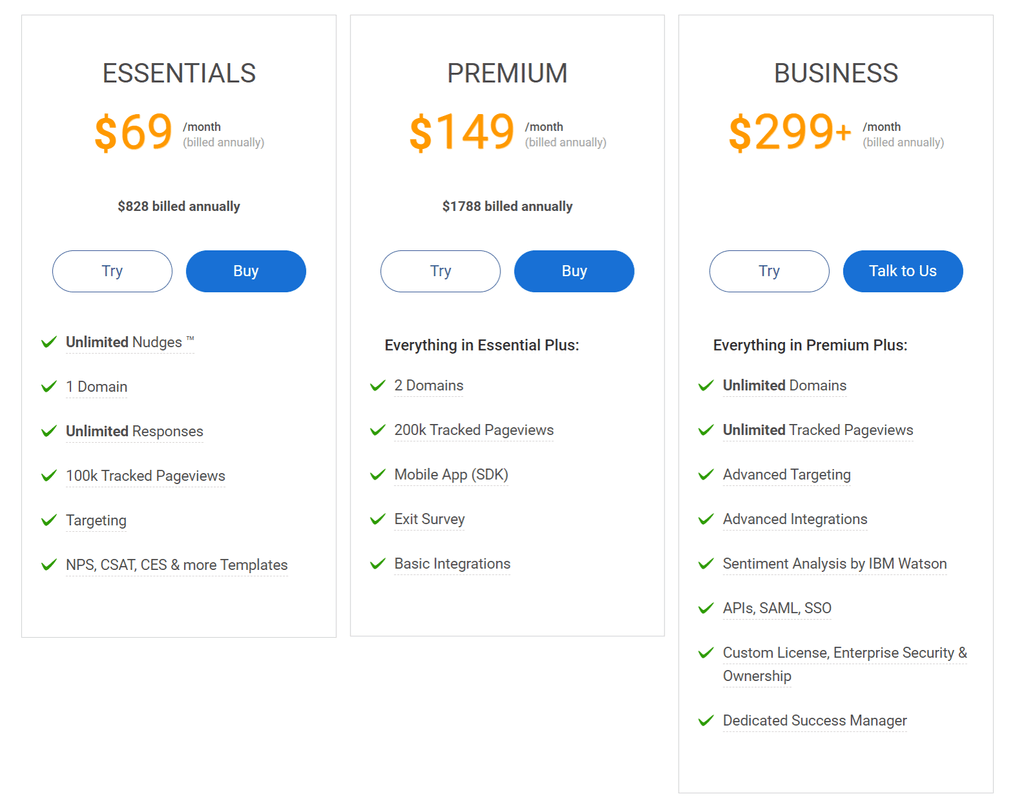
To track more than 100k monthly page views or more than one domain, you’ll need to upgrade to Premium ($149/month) or Business ($299+/month). Premium is a good choice for most businesses since it also gives you access to the mobile SDK.
Pros & Cons
Pros
- Wide range of question types
- Advanced targeting options
- User-friendly interface
Cons
- Can be expensive in conjunction with other software
- Customization options can be limited
- Data exports can be difficult to navigate
5. Keap
Best Small Business CRM
Keap is a powerful small business CRM that can help you boost retention by delighting your customers with a top-notch experience.
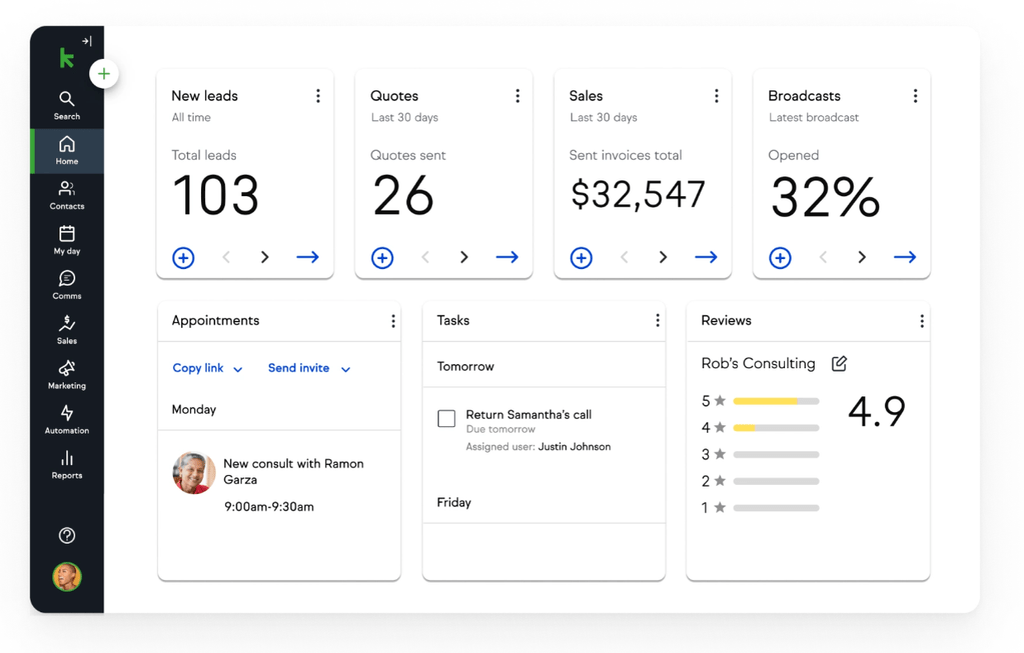
There are a few retention-boosting features under the hood, but Keap’s real power as a customer retention tool comes from its ability to organize a range of small business processes under one roof. Except for customer service, Keap handles it all—billing and invoicing, sales, marketing, and scheduling.
When your business is organized, you’re much more likely to deliver the kinds of experiences that keep customers coming back.
Key Features
- Reporting & Analytics: Set retention goals and make tangible progress thanks to insightful analytics and reports.
- Sales Automation: Make every customer feel heard by automating scheduling and follow-ups.
- Smart Forms: Collect feedback from customers to get inside their heads.
Pricing
Keap offers two paid plans—Pro ($159+/month) and Max ($229+/month). Both are customizable based on the number of contacts you need.
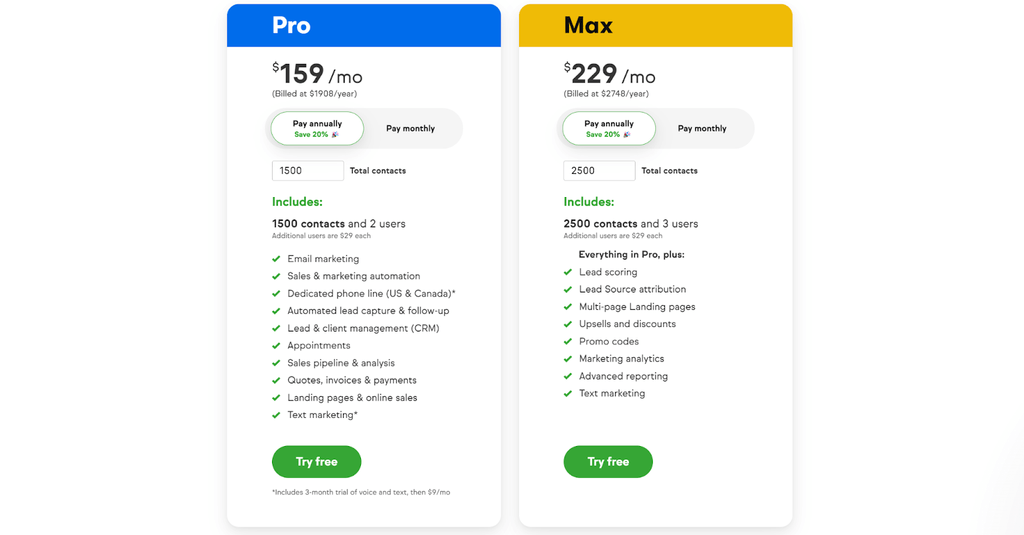
Pro is a great choice for most businesses, but you’ll need to upgrade to Max for advanced features like lead scoring and text marketing.
Pros & Cons
Pros
- Centralized communication & automation
- Offers solid (albeit basic) CRM functionality
- Easy to set up and use
Cons
- Limited customizability
- Limited API support
- Pricey compared to competitors
6. ActiveCampaign
Best for Personalizing Sales & Marketing
The ActiveCampaign platform spans marketing automation, email marketing, and CRM.
As a customer retention software, ActiveCampaign excels thanks to powerful personalization features that allow you to meet customers where they are. From predictive email sending to targeted upsells based on CRM data, ActiveCampaign adapts to your customers to win repeat business.
Key Features
- Customer Experience Automation: Build automated experiences that feel natural using advanced funnels and triggers.
- Conditional Content: Create custom messages for each customer based on their past behavior and stage in your funnel.
- Lead Scoring: Automatically score leads based on specific criteria to prioritize outreach and support.
Pricing
ActiveCampaign prices its marketing, sales, and email products separately, so if you want access to all the features we covered above, your best bet is a bundle.
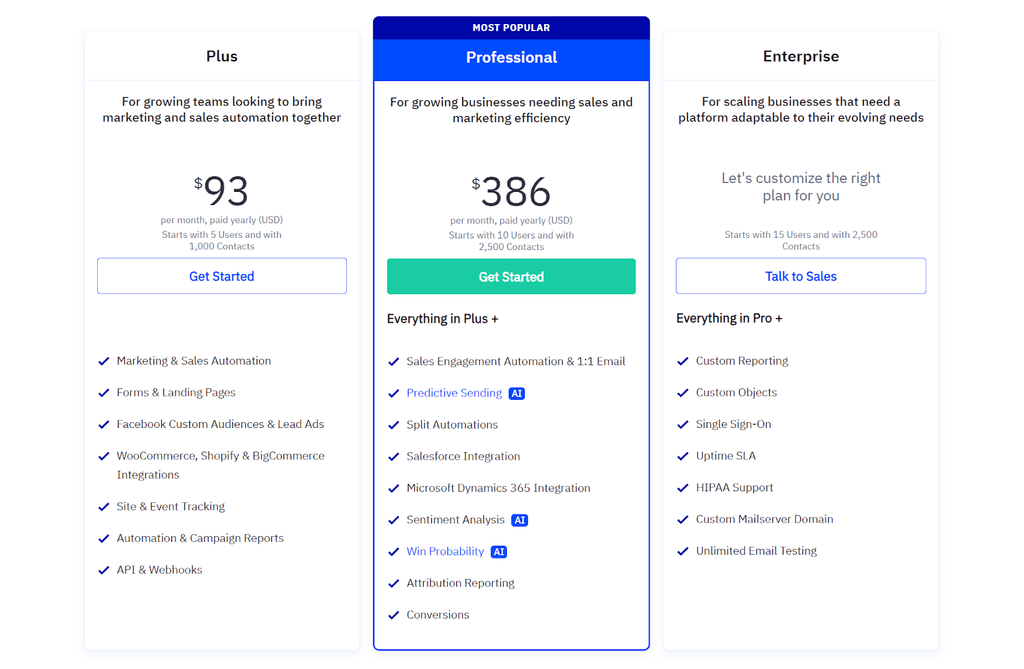
Plus ($93/month) supports marketing & sales automation, along with a ton of other core features. Professional ($386/month) is where you start to see advanced features like predictive sending and sentiment analysis.
You’ll need to contact sales for a quote for Enterprise.
Pros & Cons
Pros
- All-in-one marketing and sales automation capabilities
- Affordable pricing
- Easy-to-use visual automation builder
Cons
- Limited social media integration
- Basic reporting and analytics
- Limited CRM functionalities
7. Userpilot
Best for In-App Experiences
Userpilot is a tool that helps product teams deliver personalized experiences that boost retention (along with a host of other growth metrics).
Userpilot makes it easy to create and launch in-app experiences like product tours, onboarding flows, and checklists that help users reach their a-ha moments more quickly. There are also tons of ways to collect feedback—about your product as a whole or specific features and UI elements.
All of this makes it much easier to zero in on the sources of user churn and counteract them through targeted guidance.
Key Features
- Product Analytics: Automatically track key usage and experience metrics without the need to program anything.
- User Sentiment: Record and track user sentiment over time to see how changes affect retention.
- In-App Experiences: Build in-app experiences that guide users to the value your product holds before they churn.
Pricing
Userpilot offers three plans—Starter ($249+/month), Growth (custom), and Enterprise (custom).
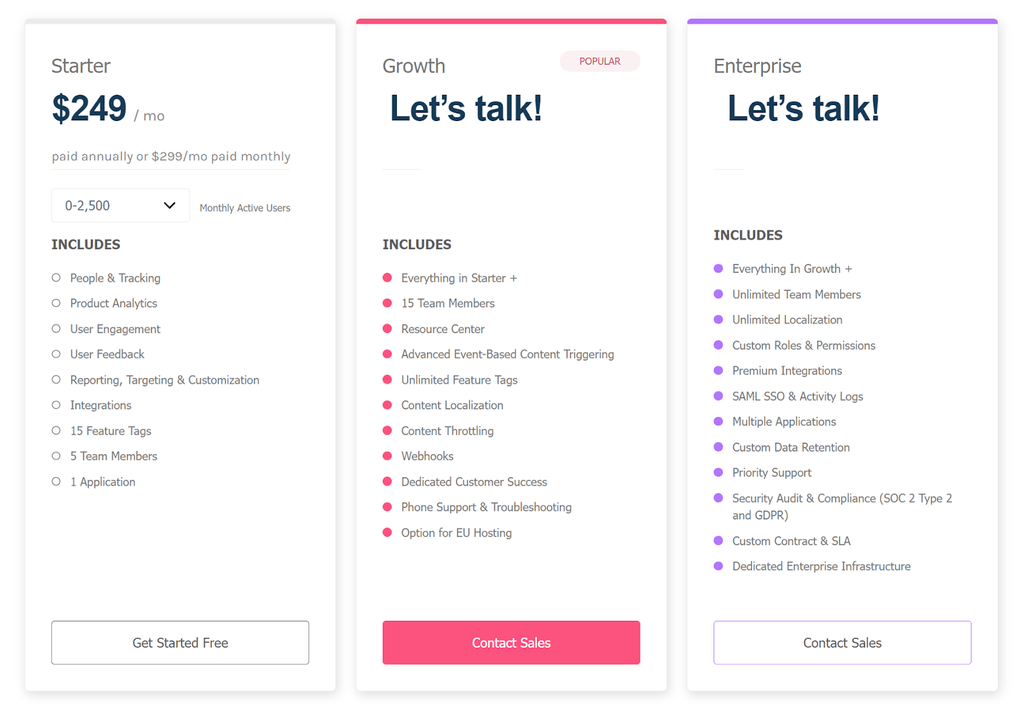
Starter supports a wide range of basic features like product analytics, reporting, and feedback, but you’ll need to upgrade for event-based targeting and unlimited feature tags.
Pros & Cons
Pros
- Easy integration
- Code-free product walkthroughs
- Personalization features
Cons
- Expensive compared to other similar options
- Limited library of pre-built guides
- Some customers experienced glitches
8. Customer.io
Best for Creating Messaging Funnels
Customer.io is a messaging platform designed to give technical marketers the tools needed to craft and send data-driven emails, push notifications, in-app messages, and SMS.
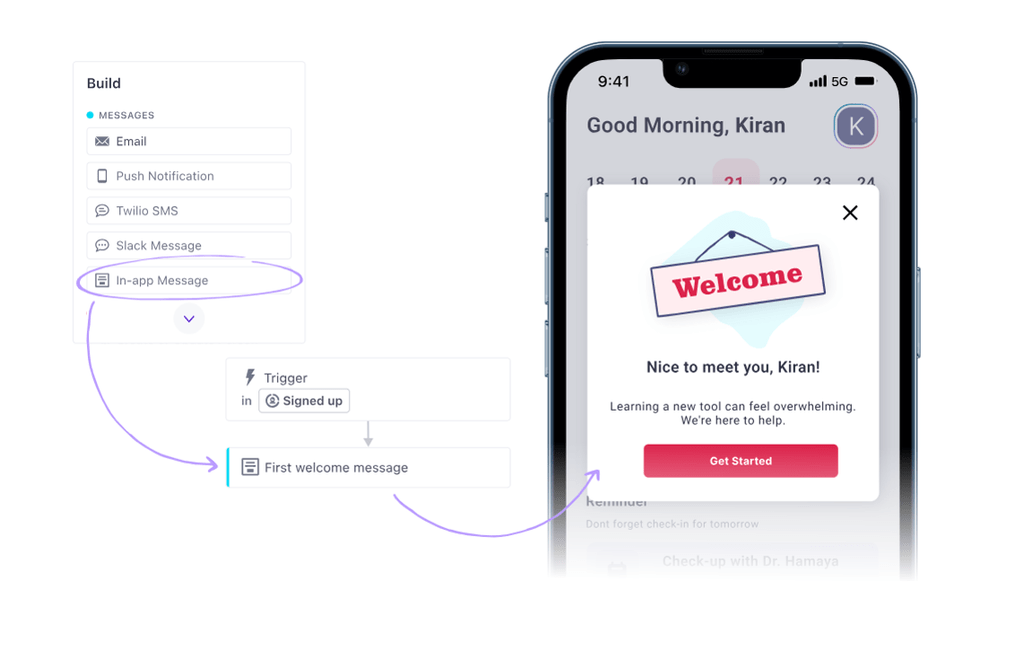
As a retention tool, Customer.io gives you the ability to set up complex funnels that educate users about your product, respond to the signs of churn, and reward loyal customers with discounts, vouchers, and add-ons.
All-in-all, Customer.io is a powerful tool for communicating with your users across a range of effective channels and mediums.
Key Features
- Mobile SDK: Target mobile app users with messaging that inspires retention and limits churn.
- Messaging Funnels: Build automated workflows that send effective follow-up messages.
- Segmentation: Create target audiences based on user data, behavior, and preferences to maximize your retention efforts.
Pricing
Essentials ($100/month) gives your team access to all Customer.io’s core features, along with a limit of 5,000 profiles.
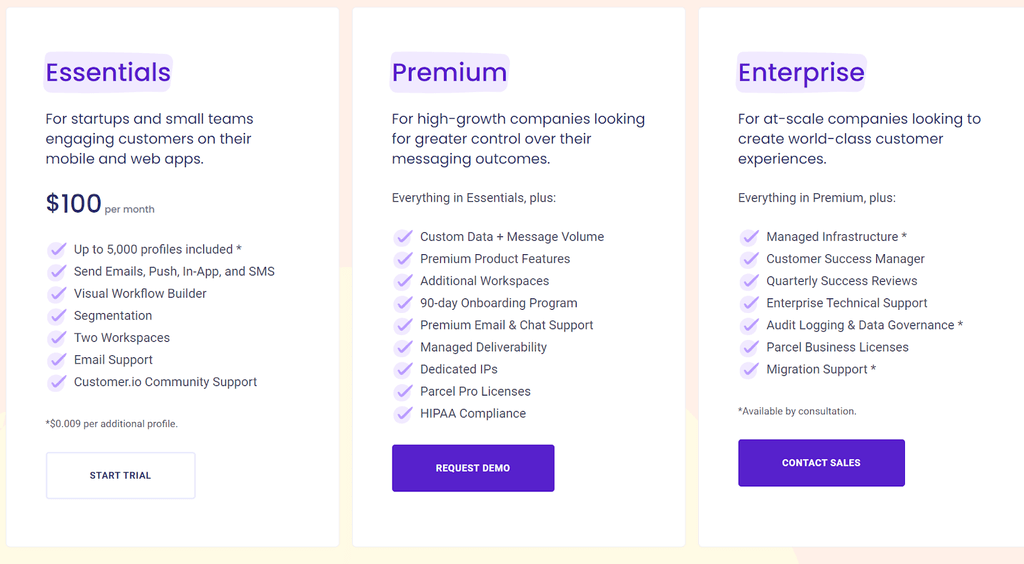
Premium and Enterprise offer advanced features like onboarding and HIPAA compliance, but you’ll need to contact sales for a quote.
Pros & Cons
Pros
- Easy-to-use interface
- Flexible messaging options
- Data-driven segmentation
Cons
- No phone support available
- Pricing tiers can be limiting
- Some technical difficulties
9. Totango
Best for Quantifying Customer Success
Totango is an all-in-one customer success platform that uses data on customer needs, preferences, and behaviors to boost retention.
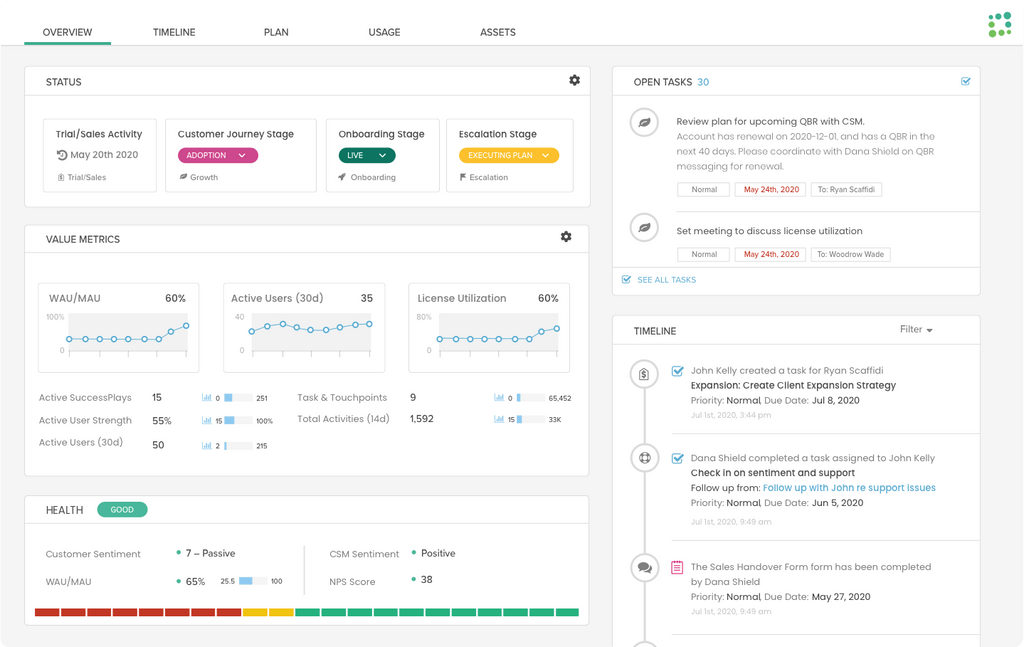
The core feature here is the ability to access a 360-degree view of each customer—including usage patterns, customer health scores, and feedback. By noticing churn signals early on, you can take action to solve the problems that are driving customers away.
You can also use Totango to automate customer engagement and communication workflow so that at-risk customers are targeted with offers, support resources, and alerts.
Key Features
- 360 Customer View: Get comprehensive customer profiles with usage data, health scores, and feedback.
- Automated Engagement: Automatically target at-risk customers with offers, support resources & alerts.
- Customer Health Score: Get a single metric that encapsulates customer health & risk.
Pricing
Totango offers three plans—Starter ($249+/month), Growth ($1,099/month), and Enterprise (custom).
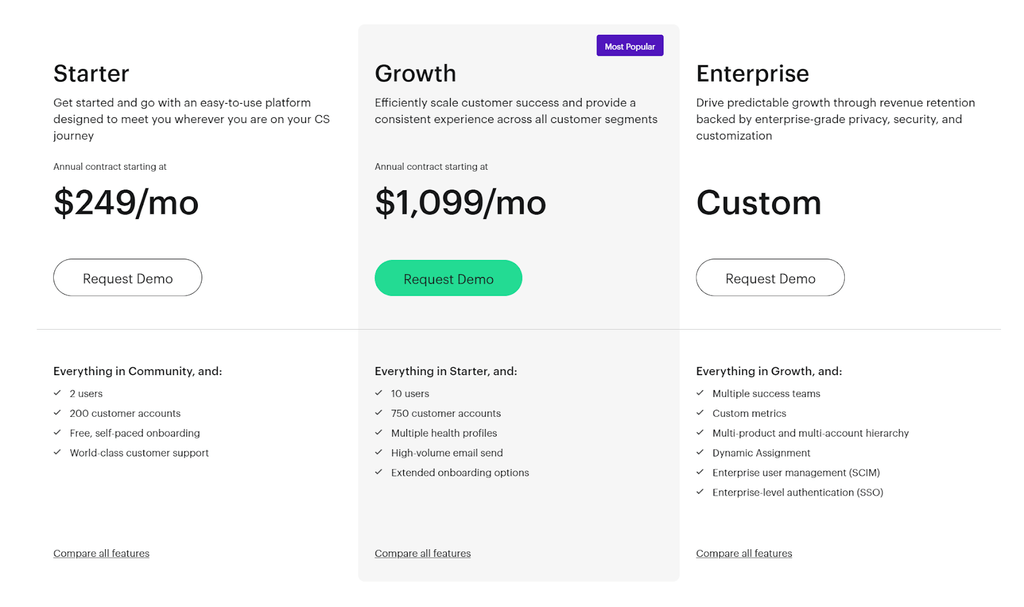
The two user limitation on the Starter plan is a tough sell, and many businesses will need to skip straight to the Growth plan. All plans are customizable based on the number of customer accounts you want to serve.
Pros & Cons
Pros
- Offers a variety of features in one platform
- Uses AI and machine learning to provide deep insights
- Comprehensive view of each customer
Cons
- Enterprise option can be quite expensive and is not openly priced
- Limited support options for the platform
- Integration issues with third-party tools
10. ClientSuccess
Best for Flexible Customer Success Dashboards
Last but not least—ClientSuccess.
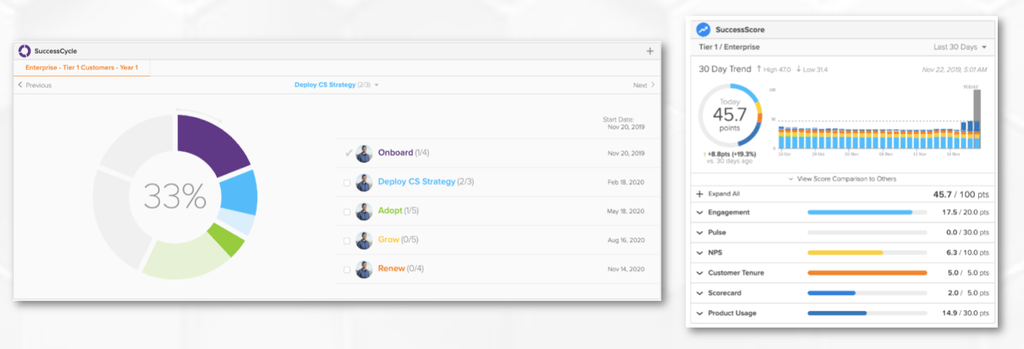
Like Totango, ClientSuccess is a customer success management platform with the tools to help you track customer engagement, health scores, usage data, and more. For example, Pulse is a powerful tool for delivering real-time customer alerts to your team, while SuccessScore offers an all-encompassing customer health score.
All of ClientSuccess’s tools work together to provide insights and guidance for improving retention.
Key Features
- SuccessScore: An all-encompassing customer health score.
- Pulse: Real-time customer alerts for your team delivered via the channel of your choice.
- Automation: Automate tedious manual customer success activities and focus on delivering superior service.
Pricing
You’ll need to request a demo to access pricing.
Pros & Cons
Pros
- Deep and actionable insights into customer behavior
- Flexible dashboard that can be customized
- Easy-to-use interface
Cons
- Limited integration with third-party software
- No mobile app available
- Steep learning curve
Use Software to Improve Customer Retention
Customer retention software can have a huge impact on your ability to keep your customer happy. You can gain insight into your customer’s needs to deliver more relevant experiences through analytics, user feedback, and automation tools.
At Customerly, we combine a range of retention-focused tools into one easy-to-use platform to arm businesses with the insights and automation needed to keep their customers engaged. Our goal is to help businesses build strong customer relationships that last.
Want to learn more? Sign up for a 14-day free trial and take Customerly for a test drive.
